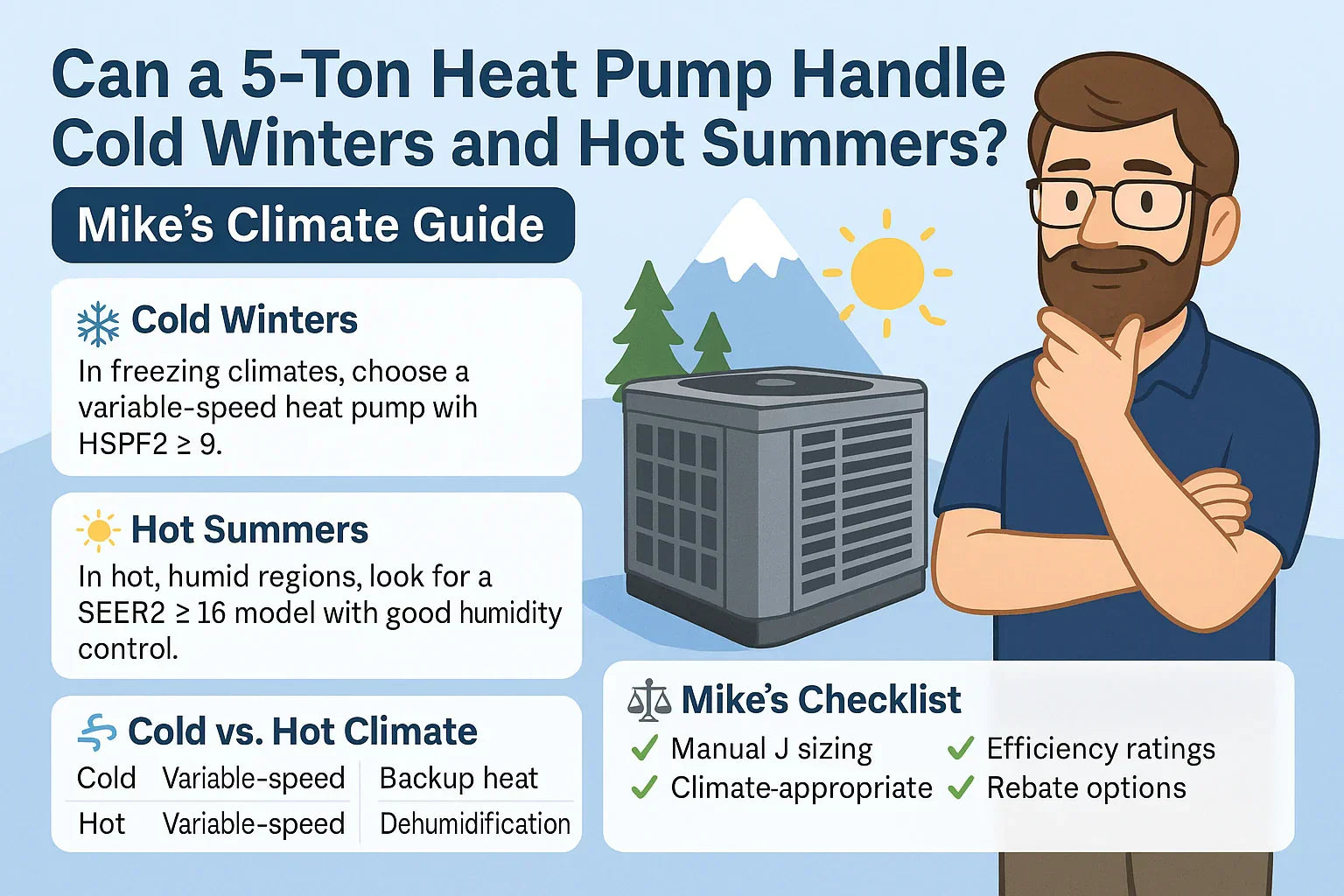🏡 Introduction: One System, Four Seasons
If you live in an area where temperatures swing from freezing blizzards in January to scorching heat in August, the question becomes: can one HVAC system handle it all? More specifically, can a 5-ton heat pump keep you comfortable through both cold winters and hot summers?
Mike is here with answers. A 5-ton heat pump is a powerful piece of equipment, but power alone isn't enough. The type of heat pump, its staging technology (single-stage, two-stage, or variable-speed), and its efficiency ratings (SEER2 and HSPF2) will determine whether it's right for your region.
Let’s break down exactly what to look for based on your climate—whether you live in snowy Colorado or steamy Louisiana.
❄️ How 5-Ton Heat Pumps Perform in Cold Winters
Heat pumps work by transferring heat from one area to another. In winter, they extract heat from outside air and bring it inside. But what happens when the air outside is freezing?
Do Heat Pumps Work Below Freezing?
Yes, but their efficiency declines as temperatures drop. Modern cold-climate heat pumps are designed to work effectively even when temperatures hit 0°F. Standard models may struggle below 30°F and require backup heat.
Key Features for Cold Weather Performance:
-
Variable-Speed Compressor: Adjusts heating capacity based on demand; more efficient and comfortable.
-
High HSPF2 Rating: Look for HSPF2 ≥ 9 for colder climates.
-
Cold-Climate Certification: ENERGY STAR and NEEP list heat pumps that maintain performance in sub-zero conditions.
Should You Add Backup Heat?
In areas that experience sub-freezing temps regularly, yes.
-
Electric Resistance Backup: Built-in heat strips automatically kick in when the heat pump can’t keep up.
-
Dual-Fuel System: Combines an electric heat pump with a gas furnace for maximum flexibility.
Mike’s Winter Tips:
-
Choose a variable-speed unit for stable comfort.
-
Opt for a model with cold-weather engineering, like crankcase heaters and defrost cycles.
-
Make sure your home is properly insulated and sealed to retain heat.
🔥 Surviving Hot Summers with a 5-Ton Heat Pump
In hot and humid climates, your heat pump needs to cool your home efficiently and control humidity. Here’s what to look for:
How Does SEER2 Affect Cooling Performance?
The SEER2 rating measures seasonal cooling efficiency. The higher the SEER2, the more energy you save. In hot climates, this is critical because cooling accounts for the bulk of your energy bill.
Two-Stage and Variable-Speed Advantages:
-
Better humidity control: Runs longer at lower speeds to remove more moisture.
-
More consistent temperatures: Reduces hot and cold spots.
-
Lower energy bills: Avoids the spike in energy from constant start/stop cycling.
When Single-Stage Falls Short:
Single-stage 5-ton units may cool too quickly, especially in homes that are well-insulated. This leads to short cycling and poor humidity control, leaving your house cold and clammy.
⚖️ Cold Climate vs. Hot Climate: Efficiency Trade-Offs
| Climate | Best Heat Pump Type | Key Ratings | Common Add-Ons |
|---|---|---|---|
| Northern (cold) | Variable-speed | HSPF2 ≥ 9, SEER2 ≥ 16 | Electric backup or dual-fuel |
| Mixed (4-season) | Two-stage | HSPF2 ≥ 8.5, SEER2 ≥ 16 | Smart thermostat |
| Southern (hot/humid) | Variable-speed | SEER2 ≥ 18, HSPF2 ≥ 8 | Dehumidifier or ERV |
The same 5-ton unit could be overkill in Miami but just right in Minneapolis if properly configured.
📊 Energy Costs in Different Climates
Your climate determines whether your biggest cost will be heating or cooling. Let’s look at two scenarios:
Minnesota Homeowner:
-
65% of energy use is heating.
-
HSPF2 rating has major impact on winter electric bills.
-
Variable-speed systems lower long-run costs even with higher up-front pricing.
Florida Homeowner:
-
75% of energy use is cooling.
-
High SEER2 (18+) is crucial to avoid high summer bills.
-
Dehumidification = comfort + energy savings.
Cost Differences:
| Rate | Monthly Usage | Monthly Cost |
| $0.15/kWh | 1,200 kWh | $180 |
| $0.20/kWh | 1,200 kWh | $240 |
In both scenarios, choosing the right efficiency level can save you hundreds per year.
🏦 Rebates & Incentives Based on Climate
Federal Tax Credit (2025):
-
30% of cost, up to $2,000 for qualifying heat pumps
-
Must meet ENERGY STAR criteria
State and Utility Rebates:
-
Cold Climate: States like MA, NY, MN offer extra rebates for systems with cold-weather certification
-
Hot Climate: Utility programs in TX, FL, AZ may offer rebates for high SEER2 systems
Find Rebates:
📜 Mike’s Real-World Examples
❄️ Minneapolis, MN
-
Home size: 2,900 sq ft
-
System: 5-ton variable-speed, SEER2 20, HSPF2 9.5
-
Installed Cost: ~$15,000
-
Rebates: $3,200 federal + $1,200 state
-
Net Cost: ~$10,600
-
Backup: Electric heat strips
🌴 Orlando, FL
-
Home size: 2,700 sq ft
-
System: 5-ton two-stage, SEER2 17, HSPF2 8.5
-
Installed Cost: ~$12,000
-
Rebates: ~$2,500 total
-
Net Cost: ~$9,500
-
Add-on: Whole-home dehumidifier
🛠️ Mike’s Climate Checklist
-
✅ Get a Manual J Load Calculation before buying a 5-ton system
-
✅ In cold climates: choose cold-climate rated units and plan for backup heat
-
✅ In hot/humid climates: prioritize humidity control with variable-speed
-
✅ Ask your contractor about dual-fuel setups for subzero reliability
-
✅ Apply for rebates early to reduce net installation cost
✅ Conclusion: Can a 5-Ton Heat Pump Do It All?
Yes—but only if you match the system’s efficiency ratings and technology to your local climate. A generic 5-ton heat pump might fall short in extreme conditions, but a well-selected, high-efficiency unit can provide reliable heating and cooling all year long.
Mike’s Bottom Line: “Don’t just buy for square footage—buy for your climate.”
In the next topic we will know more about: Maintenance Tips for Your 5-Ton Heat Pump: Filters, Coils & Seasonal Care







